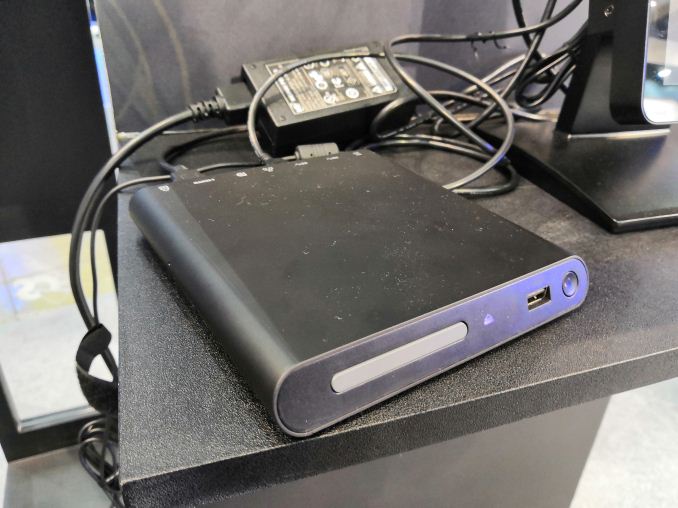ECS with Intel Compute Card: What Happened to Intel’s Compute Card?
by Ian Cutress on June 19, 2018 2:00 PM EST- Posted in
- Systems
- Intel
- Trade Shows
- Core M
- Compute Card
- Computex 2018

One of the more interesting and innovative platforms that Intel has introduced over the past few years was the Compute Card: a small credit-card like platform that contained a CPU, some memory, some storage, and a connector such that the card could be placed into all manner of docks and displays for a universal homogenous experience. The Compute Card arrived with much fanfare, but since then I have not heard much about it, let alone see one in real life. That changed with a visit to ECS at Computex.
ECS is one of Intel’s biggest engineering and manufacturing partners, taking on a lot of the Intel branded product contracts, such as the NUC. On display at their booth was the Intel Compute Card platform in two variants: first, a dock embedded in a touch screen display, and second as a dock that could be connected to a display. It’s that second one that interested me most.
Because the Compute Card is small, and super thin (it’s difficult to get over just how thin it is), the idea that you can take almost a full x86 computer with you to different points is pretty crazy. This is the point where someone mentions a smartphone, which I concede, but the Compute Card is so much smaller. The base design has either a Core-Y series processor or an Atom processor inside, and the dock provides the additional cooling and extension to things like networking, display, and USB. It’s like putting a credit card in a DVD drive hooked up to a monitor.
The one thing about when the Compute Card was launched that didn’t click immediately was the thermals. The docks in this case have to assist with the cooling – the thin metal chassis of the compute card is not enough, especially when the CPU can draw up to 6W. As a result, when a user needs to remove the Compute Card, they have to wait until the temperature decreases to something human friendly. Both myself and Anton commented that after ejecting the Compute Card, the temperature of the unit was quite toasty.
The dock ECS had on display was the DK132EPJ, or what Intel calls the ‘Port Jefferson’ platform. My ECS contact said, when I wanted to have a look at the Compute Card devices, ‘why do you want to look at something so old?’. The question itself kind of shows the two points about where the Compute Card stands today: not only have I not seen it up until now, it also has not been updated to the latest designs. It would seem that the power it provides is already sufficient for the markets its wants, or future products might be too power hungry for it.
Is the Compute Card a success? I don’t really know. If it’s taken me this long to even see one in person, then it’s either a ‘no’, or I’m just not following that market often enough. If one thing is for sure, there haven’t been any updates from Intel, which is a shame.
Edit: Imagine a cluster of these things: a dock that supports a hundred of them.
| Want to keep up to date with all of our Computex 2018 Coverage? | ||||||
 Laptops |
 Hardware |
 Chips |
||||
| Follow AnandTech's breaking news here! | ||||||















26 Comments
View All Comments
cekim - Tuesday, June 19, 2018 - link
VMs make sense if you have good connectivity and can handle latency. I think the mismatch between this idea and the market is that the applications where it makes sense to have a discrete PC with power beyond that which a Raspberry Pi can provide also require more graphics, ram and storage than such a solution can provide at present. It's too big to be small and too small to be big.If/when GPUs shrink down to this foot-print, the perennial problem of cloud gaming goes away. However, GPUs still have not reached the point where giant power sucking max aperture dies can't still provide noticeable improvements to the user experience. You can get away with a low-end CPU and game (graphic/latency sensitive games), but not a low-end GPU.
Make a compute card that can realistically replace a Game Console and you've got something...
Computer Bottleneck - Tuesday, June 19, 2018 - link
I really like this idea and concept, but I think it would be better with a laptop housing.Alexvrb - Tuesday, June 19, 2018 - link
Agreed. Something like HP's MeDock but not overpriced. Make it an open standard so there's competition. A shell with a display and battery should be like $100-300 depending on how large and how fancy (display/chassis quality, touchscreen, etc). Could even have various sizes of tablet form factor shells! I think this was a missed opportunity... or maybe they just didn't want to piss off OEMs that sell traditional machines.thrawn3 - Tuesday, June 19, 2018 - link
These already make tons of sense for kiosks which I think has been mentioned but in an ideal world I think that TVs should have a standard docking option that can use either one of these Compute Cards or a Raspberry Pi and have all smart TVs be required to use that option. How stupid is it to have a TV that can be bricked with a software issue or even just that the "smart" features get outdated in a fraction of the time the display is good for.Alexvrb - Wednesday, June 20, 2018 - link
Yeah "smart" TVs are terrible. In addition to the issues you mentioned, they can also become a security risk. Most of the manufacturers out there absolutely suck at security, and on top of that they don't update them forever. Better to have a swappable card or an external box, preferably something supported for a long time with heavy emphasis on security.Wardrop - Tuesday, June 19, 2018 - link
If implemented correctly, these could be the future of all-in-one type devices. If they managed to get the performance close to a normal corporate desktop, I imagine every desk just having a monitor (with slot for computer card) and keyboard and mouse. Would make rollouts and troubleshooting a breeze.Spunjji - Wednesday, June 20, 2018 - link
Long-term support, on the other hand..."Yes, helpdesk? I washed / lost / ran over / my dog ate my compute card. We have a backup of all the data I had stored in that one location though, right?"
Unfortunately it rapidly becomes a terrible idea when you think about how actual, non-techy users will interact with it.
Alexvrb - Wednesday, June 20, 2018 - link
I'm not reading his post the same way you are. I don't think he intends for them to be removable by anyone but IT. You could even physically secure them (lock) to the monitor/dock they attach to, so they can't just slip it in their pocket.sgeocla - Wednesday, June 20, 2018 - link
In these small form factors I doubt very much that they can compete with ARM. Even running the Windows on ARM version and in the same power envelope the performance difference would not be that high, especially when comparing ARM 7nm vs Intel 14nm+++.The price would also be much lower for ARM version, helping broad market adoption.
fteoath64 - Wednesday, June 20, 2018 - link
Only reason Intel is pushing this is because of x86, thus Windows compatibility. If using Linux or Android, it has no chance against Arm!. Thats clear in terms of both price and performance. One can tell a SnapDragon 835 in it, kills the Intel part instantly!.